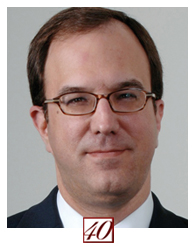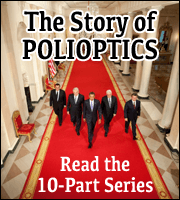 Jeremy Gaines and Edward Adams are our guests this week.
Jeremy Gaines and Edward Adams are our guests this week.
Show produced by Katherine Caperton
Original Air Date: October 8, 2011 on SiriusXM Satellite Radio “POTUS” Channel 124
Listen to the show by clicking on the bar above.
Show also available for download on Apple iTunes by clicking here.
I may as well start with the full disclosure: Jeremy Gaines and I go back a ways.

Gaines
While I was plying the country as an advance man for Bill Clinton in the spring and summer of 1992, Gaines, just out of Northfield, Minnesota’s Carleton College, was making his way toward the campaign.
While I was dispatched from the Democratic National Convention in New York City to help produce a stop in Weirton, West Virginia for the famous first bust tour of the Clinton/Gore Campaign, Gaines was at the wheel of a rental van, shepherding reporters and photojournalists through the Lincoln Tunnel. His target: finding strategic locales where the lenses could intercept the rolling road show and record it as vintage political Americana.
While I moved onto build campaign sites in other parts of the country, Gaines became a stowaway, literally, on Governor Clinton’s campaign plane — just walked up the back staircase as if he was ticketed in coach– and found himself, with his single suitcase, in Little Rock, Arkansas. Once there, he promptly found lodging in a group apartment and burrowed into the headquarters press office for the many-month run toward election day.
Jeremy would assume any role needed to get the job done. A nice Jewish boy from Los Angeles, he became “Jerry McGaines” to serve as Clinton’s liaison to the Irish press covering the campaign.
On election night, November 3, 1992, Gaines and I converged again outside the Old State House for the victory speech by the President-Elect. Gaines then stayed in Little Rock for the months of transition, and I headed to Washington to work on the Presidential Inaugural Committee, both of us unsure where the future would lead.

Clinton returns to Little Rock
The future led, a few months later, to 1600 Pennsylvania Avenue, where Gaines managed to sneak through the gates on Inauguration Day, 1993 and remained on the White House Staff until 1998.
My route through the White House is well chronicled on this site. But less known is the fact that Gaines and I were often side-by-side through those most of those years, and traveling together on so many of those trips. From day trips with the President to sites around the Beltway, to the most remote outposts of Kuwait, Haiti or Russia, we worked to keep the press pool in tow, helped to set up iconic moments for the President, and watched each other’s back as best we could.
So it was fitting, as Jeremy and I found ourselves back in Little Rock last weekend for the 20th Anniversary of Governor Clinton’s October 3, 1991 Announcement of Candidacy, that the normally reticent Gaines would finally consent to coming on our show. There was so much material to discuss, just by examining the artifacts in front of us.
[youtube]yXxuWUo-fEQ[/youtube]
The return visit to Little Rock was itself a voyage back in time. Parades of people we knew and worked with — on the campaign and in the White House — strolled Markham Street from the Peabody Hotel (formerly the Excelsior), through the rejuvenated restaurant district, to the exquisite Clinton Presidential Center on the eastern edge of downtown. Many old friends looked more or less the same. Most rivalries of the past seemed to mellow with the years. There was pause to remember some of the hundreds we knew who are no longer with us and died too young, among them advance men Charlie Duncan, Lawry Payne and Bruce Garamella. A few toasts were raised in their memory. And more drinks were had.

A building that serves as the metaphor of the Bridge to the 21st Century
The exhibition in the Clinton Library, organized chronologically and also by major pivot points in the President’s two terms, is dotted with memorabilia (some of it, my own). The objects inside the glass-enclosed cases bring back an age before the Internet, when we wore pagers instead of Blackberries, and when events — like the Rabin-Arafat handshake, the signing of the Balanced Budget Act and the passage of NAFTA, with all former living presidents present — seemed to heal, rather than heighten, political discord. Comparing these images with snapshots we see coming from Washington today, their gravity feel almost pre-designed to hang in a presidential library.
That was all prelude to the main event: the late Saturday afternoon speech, staged in front of the Old State House at in perfect light at Magic Hour. The crowds assembled just as they had to hear Bill Clinton in 1991 (announcement day), 1992 (election night) and 1996 (re-election night). The weather was fine. The setting was perfect.
Rodney Slater and James Carville, fixtures on the campaign plane and in the famous War Room, provided a warm up. Rodney looked no older when he walked off the Governor’s 737 at any of my events. If possible, James looked even younger, still fitting into the exact same rugby shirt and jeans he wore throughout the acclaimed documentary by Chris Hegedus and D.A. Pennebaker.

Two for the price of one
The stage was then cleared of the pre-program and the public address system piped up with, yes, Fleetwood Mac’s “Don’t Stop Thinking About Tomorrow.” It was the political equivalent of Marty McFly and “Doc” powering up the flux capacitor in their DeLorean DMC-12 and heading back to the future. Walking out into the evening Arkansas air from the Old State House door, just as they had 20 years ago, was the 42nd President of the United States accompanied by his wife, Hillary, former First Lady of Arkansas, former First Lady of the United States, former U.S. Senator from New York, and currently our Secretary of State (forget Bill for a moment — it’s hard to imagine a comparable record of public service of a modern politician that approaches what Hillary has accomplished).
Michael J. Fox and Bill Clinton have both weathered health challenges since they worked in the White House in the 1990s (Fox, in the movie The American President, and Clinton, as the genuine article), but based on their public performances this year, they still can conjure old-tyme charisma. Fox was funny and fabulous in this year’s eighth season of Curb Your Enthusiasm on HBO. A significantly slimmer Clinton, in turn, showed that he, too, could still suit up for a sequel. His words issued forth with less rapid fire than years past; his voice didn’t hit the same octaves; his pauses stretched a beat longer. But his message still resonated deeply with the assembly that continues to stick with him “’til the last dog dies.”
[youtube]m4VatyYq2rw[/youtube]
Gaines and I left Little Rock on Sunday, full of admiration for our old friend Stephanie Streett, executive director of the Clinton Foundation who, with the reunion, pulled off a logistical triumph in short order. She got a big assist from social media that seemed to build daily momentum for the mass convergence on Little Rock. Longtime Clinton aide Greg Hale, like movie director Edward Zwick recreating the assault by the 54th Massachusetts on Battery Wagner in Glory, pieced together all of the key elements of the 1991, 1992 and 1996 Old State House events to assemble a living diorama of Clinton history. Bathing the stage in late afternoon light, made more dramatic by the cookaloris effect of the sun passing through the Markham Street arbor, didn’t hurt either.
It’s 2011, of course, and when Gaines talked to Adam Belmar and me on Polioptics on SiriusXM POTUS Channel 125, we had to cover the

First Lady at Target
here and now, from the competitive fever that drives the positioning of MSNBC against CNN and Fox News Channel, to Steve Jobs’s legacy as the ultimate communicator, Chris Christie’s bow-out and Michelle Obama’s Target shop-op.
This narrative doesn’t begin to describe the routine challenges Gaines faces as the chief spokesman for MSNBC. If you watch long enough, and read the media blogs or New York tabloids the next day, you’re bound to find traces of his work, either on-the-record or blind-sourced. There you’ll find Gaines, offering his interpretation of the latest ratings, positioning the channel’s new promotional campaign or, as he has so many times in years past with the likes of Jesse Ventura, David Schuster or Keith Olbermann, meting out the public reprimands of talent gone awry. We’re only at the beginning of the campaign season and those who could take offense to on-air banter are in unlimited supply. These will be busy months ahead for Jeremy Gaines.
* * *
Adam Belmar and I are gratified by the many people who listen to our show on the air on SiriusXM on the weekend, or download it later on iTunes or stream it on this site. We’ve heard from many of you, and we were particularly intrigued by an email we received from Edward Adams. A few days later, he was on the air, taping our show with us.

Edward Adams
Ed Adams has long been at the intersection of the law and how it’s covered by photojournalism. He’s written for the New York Post, New York Law Journal, and served as editor and publisher of the ABA Journal and publisher of the American Bar Association. Compared to Congress or the White House, which run massive public relations machines, Adams sympathizes with the challenges faced by the public information officer at the U.S. Supreme Court who faces a demanding public and media and famously reticent justices continuing to bar video or photography in the chamber.
As Ex-SCOTUS Justice David Souter once said “the day you see a camera come into our courtroom, it’s going to roll over my dead body.” And yet, as Ed pointed out to us, “these public affairs folks have to work in a world in which visuals are vital to telling the story. (And when Justice Scalia had a book to sell, he went on 60 Minutes.) It’s a challenging job, to say the least.”
So it was Ed’s detour into government service that intrigued us. We pick up his narrative from here:
“I served as the public information officer at the federal court in Alexandria from 2002-2006. I was the only such person in a federal trial court nationwide, in large part because of the spate of terrorism cases the court had on its docket after 9/11…
“The court was concerned about reporters making mistakes when reporting the complicated verdicts in the Zacarias Moussaoui case — the so-called 20th hijacker on 9/11. So we became the only federal court ever to simultaneously announce the verdicts in the courtroom and at the pool mic stand in front of the building…
“Backstory: ABC mounted a camera on the roof of a nearby building, so their reporter could step out of the courtroom and hold a guilty/not guilty sign up at the 7th floor window, beating everybody else by a minute or two. Only problem was the camera could also see into the jury deliberation room. US Marshals pulled that camera down right quick, and that’s what convinced the court to announce the verdicts in front of the building.
“Concerned about terrorist attacks on Moussaoui jurors, the court banned any photographs of them. And yet we had hundreds of prospective jurors lined up to enter the building — right in front of dozens of still and video cameras. My job was to quietly convince the assembled shooters to photograph them in such a way that they couldn’t be identified — without the request itself becoming a story. Everyone complied, except one shooter for a European photo agency. I tracked down his editor and convinced him to put out a kill order on the shots; fortunately, no one used them…
“Once the jury was selected, Moussaoui jurors were taken to and from the courthouse in unmarked vans. The AP decided it would be a good idea to follow the van one day near the end of the trial, so they would know where to interview jurors after the case concluded. That set off a crazy chase that ended with the AP reporter’s car pulled over by a menacing group of Marshals, and a rather heated conversation between me and the AP DC bureau chief.
“My courthouse banned not just cameras, but all electronic devices from the building. It almost took a court order for me to rescue a CNN reporter’s breast pump from the clutches of the Marshals.”
This is the way it looked to assembled cameras as Ed Adams emerged from the Federal Courthouse in Alexandria, Virginia to read the Moussaoui verdict:
[youtube]Cwak3PAWI1c[/youtube]
Following up on his email to Adam and me, you can hear our conversation with Ed on Episode 29 of Polioptics.


Leave a Reply